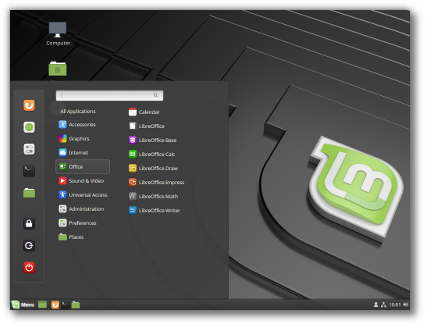Nanotechnology is evidently a very popular buzzword, comprising of several remarkable applicabilities in Science and Technology. In this new article for Open Science and Artificial Intelligence, we will explore how both of them impact Nanotechnology research.
Trivia: The term “Open Source” was coined by futurist Christine Peterson, who is an American nanotechnologist and also the co-founder of Foresight Institute, which is primarily focused on Nanotechnology research.
What is Nanotechnology, again?
Before understanding what Nanotechnology is, lets first look into the term “nano” (this might remind you of the text editor that is a favourite of many of us Linuxers in the FOSS community!). In both the cases, “nano” simply refers to a scale of measurement. For example, if we want to measure distance in nanometer (nm), a comparable value in meter would be:
1 meter = 1000,000,000 nanometers;
that is, if you take 1 billionth of a meter, what you get is 1 nm. So, it is an extremely small scale of measurement. The video included in this section takes you to that small scale and explains Nanotechnology in a very simple manner.
Nanotechnology is the implementation of different techniques using Science, Engineering and Technology in order to study phenomena at the nanoscale. In general, such studies are carried out in the range of 1-100 nm.
Why is Nanotechnology so significant?
Nanotechnology is of immense significance due to its wide variety of applicabilities in diverse fields such as biology, physics, chemistry, material sciences and many others.
It would be much easier to further understand its significance if we talk about some of the noteworthy applications of Nanotechnology as follows:
1. Healthcare
As we already know that Nanotechnology works at the Nano scale, it means we can work at the molecular and subatomic level. Nanomedicine, for instance, has a created a revolution in the field of drug delivery because nanotechnology enables the therapeutic molecule (contained in the medicine) to lock on to the desired protein right on target after consumption. This is carried out with the help of Nanoparticles.
It is due to Nanotechnology that chemotherapy can now be focused only on the disease affected area, ensuring the whole body need not go through the process of cancer treatment. Thus, the immune system is saved from getting destroyed as chemotherapy involves the use of toxic chemicals to get rid of cancerous regions.
2. Nanorobotics
You might have already heard about Nanobots. As we have discussed just earlier about the term called “Nano”, Nanobots are intelligent machines that are built on the Nano scale.
Nanobots are extremely helpful in medicine and industry. They can be preprogrammed to carry out a specific task. For example, Nanobots can be used to tackle oil pollution in a very effective manner, thus helping in cleaning up the environment.
AI (Artificial Intelligence) today greatly empowers Nanorobotics. We will talk about it in brief in a later section where we will see how AI and Nanotechnology converge with each other so effectively.
3. Biomaterials
Biomaterials are substances that are medically used for therapy of a disease or diagnosing one. They can include living tissue or artificially created material for use in biological systems to repair, replace or stimulate a damaged biological function. In the above video title, Biomimetic, as the word hints, implies mimicking the behaviour of any specific biological system.
Since Nanotechnology allows nanoscale level precision, it is a boon for developing Biomaterials. For example, in bone tissue engineering, ceramics, polymers, metals and composites can be developed at the nanoscale allowing extreme accuracy. Such nanophase biomaterials are of great significance in orthopaedic implants.
Why do we need Open Source Nanotechnology?
An article named “Make nanotechnology research open-source” on the Nature journal, encourages the adoption of an Open Source Approach and explains in a very simple manner about how innovation in Nanotechnology can be greatly hindered by patent abuse.
Excessive patenting in Nanotechnology leads to:
- increases in costs,
- slows down technical development and
- removes fundamental knowledge from the public domain
There is also a separate section in the article titled “Open Source Alternatives” which clearly highlights how an Open Source Model would allow Nanotechnology companies to freely use the best tools, materials and devices available for carrying out research and using the technology without worrying about IP monopolies.
License fees would be eliminated thus reducing costs. Such savings can be used for innovating instead, which is very necessary for a company to survive. This openness also creates scope for small startups to enter the market and innovate in Nanotechnology research.
The field of nanotechnology is a combination of information (such as chemical formulae), software (for example, modelling tools) and hardware (such as atomic force microscopes). All three areas can adopt open-source principles, and some steps have already been taken towards this.
Pearce, J. M. (2012). Make nanotechnology research open-source. Nature, 491(7425), 519-521. doi:10.1038/491519a
An Open Science Approach towards Nanotechnology
Now that we have seen how Open Source revolutionizes Nanotechnology Research, let us discuss in detail about three important initiatives in Open Source Nanotechnology. If we recall from our first Science article, Open Science implies Open Source, Open Access, Open Data and Open Standards.
1. nanoHUB: A Massive Open Source Initiative in Nanotechnology
Also mentioned in the article that we just discussed, nanoHUB is an initiative that was initially begun in 2002 by the US National Science Foundation, who established a university network called the Network for Computational Nanotechnology (NCN), to support the National Nanotechnology Initiative.
nanoHUB.org has facilitated researchers, educators, and professionals to collaborate and share resources in order to solve nanotechnology problems.
NCN has three noble goals:
- bringing computational tools online,
- making the tools easy to use, and
- educating users about the tools and nanoscience.
Read more about it on the paper here which has been written with an educational perspective. You can also read a more recent paper here which contains some useful references on nanoHUB.
2. caNanoLab: To speed up the use of nanotechnology in biomedicine
Another Open Source Initiative, caNanoLab enables data sharing to make the use of applied nanotechnology more convenient. The portal enables information sharing across research communities to accelerate and validate the use of nanotechnology in biomedicine.
Just like Bioinformatics (as we discussed in a previous Open Science article), Nanoinformatics has also emerged as a field of study. It primarily deals with any data related to Nanotechnology. After this data is collected and validated, it is stored and analyzed through various methods for useful applications. caNanoLab makes Nanoinformatics studies much easier.
3. NBI: Nano-Biomaterials Interactions Knowledgebase
The NBI Knowledgebase was created for use by the industry, academia, the general public, and regulatory agencies as a platform for an unbiased understanding of how biological systems are affected by nanomaterial exposure.
On the portal, you will find two sections:
Nanomaterial Library
Here you can look up a library of Nanomaterials with notable parameters like material type, core, surface chemistry, shape, charge, size and dendrimer generation.
Analysis of Nanomaterials
This section has all the parameters as in the library but with two additional options named Heatmap and Plot intended for analytical display.
Now that we spoke about three Open Science Initiatives in Nanotechnology, let’s conclude this section by leaving this link containing some exhaustive resources for Nanotechnology research. The page is intended for the eNanoMapper database which also contains links to other initiatives.
Open Source NanoAI: Open Convergence of AI and Nanotechnology
Its very obvious that somehow or the other, AI (Artificial Intelligence) and Nanotechnology had to make a convergence one day. This has opened up a whole new era of amazing possibilities.
Today’s AI can now solve many challenges faced by nanotechnologists. Some of the ways are listed as under:
- Interpreting results obtained from Nanoscale experiments
- Estimation of multiple parameters effectively
- Automatic characterization of Nanomaterial properties and complex I/O responses
- System optimization
- Data and algorithm design for Nanocomputers
Read more about Artificial Intelligence and Nanotechnology here.
If we think of all of the above applications of AI in Nanotechnology with an Open Source Perspective, we can clearly perceive the elevated benefits. Nanotechnologists can collaborate effectively by sharing open information, source code and datasets that can efficiently speed up Nanotechnology research with applied AI.
So, Open Source NanoAI facilitates working with FOSS that involves software that implements both Artificial Intelligence and Nanotechnology.
Did you know that AI could use nanotechnology to create human-organs for replacement and repair of damaged ones, allowing people to live on longer? There’s more, AI can even be used to create artificial meat from nano-stem cells!
Stem cells, as we see, can very much be used for a higher purpose. With Nanotechnology, stem cells can be transformed into bone cells on command. The process can also be used to treat deadly conditions such as heart disease and Parkinson’s.
AI is a driving force in Nanorobotics in the application of therapeutics that involve the immune system. Nanobots can make use of unsupervised machine learning to identify damaged human cells. All of this is possible because AI programs can tell Nanobots about differentiating between good and bad cells with the help of a vast library included within the system consisting of all knowledge about Nanoinformatics and our human body.
Read more about the application of AI in Nanorobotics here.
Ongoing Research in Nanotechnology
Let’s now look into some interesting research work that has been happening in the field in recent times. We found many and picked two:
1. Formulation of nanoparticles to promote crop immunity
This can be applied in rice crop fields to make rice plants immune to fungi, which can prove to be great news for farmers and agriculturists.
doi: 10.1101/339283
2. Delivering medicine through nanocarriers via nose-to-brain
Nasal delivery of surface modified nanomedicines has been proposed for the treatment of several central nervous system conditions including:
- Migraines
- Sleep disorders
- Viral infections
- Brain tumors
- Multiple sclerosis
- Schizophrenia
- Parkinson’s disease
- Alzheimer’s disease
- Obesity
Benefits of this research are that the side effects as in traditional drugs need not be worried about since nanocarriers can completely bypass the blood-brain barrier through nasal delivery.
doi: 10.3390/pharmaceutics10010034
Summary
So, in this Open Science and AI article, we introduced how Nanotechnology works and why it is an important field of study. We shared three examples, namely, Healthcare, Nanorobotics and Biomaterials. We then saw how Open Source Nanotechnology is a greater necessity to carry on tasks and research on the same more effectively.
Further on, we saw how an Open Science Approach drives Nanotechnology at a rapid pace. We saw three Open Science Initiatives, namely, nanoHUB, caNanoLab and NBI.
We also highlighted how AI and Nanotechnology converge for a common purpose and finally, we noted some ongoing research work in the field of Nanotechnology.
Thank you for reading. Please share any feedback that you would like to share in the comments section below. Our next article is going to be about 3d printing that would also include some discussions about interesting nanoscale applications.








